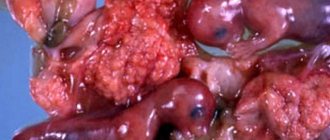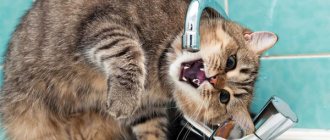If a cat pees blood, this is a very serious symptom. Cat owners should pay attention to this sign, and also try to notice how the act of urination occurs. If the cat strains and urine comes out drop by drop, you should immediately consult a doctor.
The doctor will certainly take a urine test and may need an ultrasound to exclude or confirm the presence of certain diseases. In our clinic it will be easy for you to do this, since veterinarians always have the necessary equipment at hand, and the clinic itself has its own veterinary laboratory.
What does urine normally look like in cats?
Normal pet urine is clear and may be pale yellow, straw, or orange in color. In many ways, the shade of urine is determined by the nature of the cat’s metabolism and its diet. It contains no inclusions. Removing decay products, salts, enzymes, vitamins, and foreign substances from the body, normally animal urine does not have a sharp, specific odor.
Causes of ICD
About 12% of domestic cats suffer from this pathology. Moreover, the disease occurs more often in males, which is due to the structural features of the urinary system - they have a narrower urethral lumen than females. Spayed cats and neutered cats aged 2–6 years are also prone to this disease. This is due to postoperative changes in hormonal levels and a slowdown in metabolism. The risk group also includes long-haired breeds and obese animals.
The main factors contributing to the occurrence of ICD are:
- poor diet high in salt or protein;
- poor water quality and/or insufficient quantity;
- systemic diseases (cystitis, urethritis);
- imbalance of mineral and protein metabolism;
- vitamin A deficiency and iodine deficiency;
- sedentary lifestyle;
- obesity;
- decreased immunity;
- constant stress;
- genetic predisposition.
Blood in a cat's urine - causes
Blood in a cat’s urine may be a consequence of disturbances in the functioning of the organs of its genitourinary tract or the presence of various diseases. These include:
- urolithiasis (urolithiasis);
- cystitis (inflammation of the bladder);
- pyelonephritis (inflammation of kidney tissue);
- diphtheria vaginitis (inflammation of the vaginal mucosa);
- other pathological conditions.
Also, blood in a cat’s urine can appear in animals whose bodies are undergoing infectious processes (one of the symptoms of viral peritonitis, piroplasmosis, leptospirosis). The manifestation of this symptom is typical for pets with oncology and cats diagnosed with helminthic infestation.
Hematuria can develop while taking certain medications: cytostatics, non-steroidal anti-inflammatory drugs, corticosteroids. As a temporary phenomenon, blood may appear after catheterization of the bladder or operations on the pet’s genitals (sterilization, castration). In some cases, blood in the urine can be detected in a pregnant cat. It is a consequence of exacerbation of chronic diseases, which can cause complicated childbirth and death of offspring.
The appearance of blood in a cat's urine can be caused by chemical poisoning. This pathological condition can be caused by injuries to internal organs received by a pet as a result of a fall from a height or a traffic accident. One of the causes of hematuria is an imbalance of proteins, fats, and carbohydrates in a cat’s diet.
- inexpensive feed,
- monotonous menu
- acidity imbalance
All this can provoke various diseases, the symptom of which is brown urine.
Prevention
Prevention of hematuria in cats is based on proper, balanced feeding, because One-sided feeding leads to metabolic disorders with all the ensuing problems. Cats benefit from the inclusion of fermented milk products in their diet as a source of calcium. Provide your cat with an active lifestyle to improve its metabolism. Never overfeed your pet because... obesity leads to a large number of metabolic diseases. Treat against helminthic diseases twice a year.
Symptoms of pathology
The presence of blood in a cat’s urine is not the only sign of diseases of the genitourinary system or injuries to internal organs. Along with it (depending on the cause of hematuria), the animal may experience:
- frequent urination;
- suffocation of general health;
- partial or complete loss of appetite;
- low mobility, drowsiness, apathy.
The cat meows loudly, trying to go to the toilet, and shows nervousness and anxiety. In six out of ten cases, the pet's body temperature rises, vomiting and other eating disorders appear.
Experiencing discomfort and pain, the animal begins to urinate in the wrong places. It loses interest in what is happening around it and tries to hide in a dark place to achieve privacy. A sick pet has a reduced response to external stimuli. It seemed like just yesterday he was actively taking part in outdoor games, he was cheerful and cheerful, but today he has difficulty moving and reacts aggressively to any touch from his owner.
Stages of kidney failure in cats
1. Latent stage of kidney disease (early). It is characterized by a decrease in glomerular filtration rate, but this does not affect the general condition of the animal and the concentration of creatinine in the blood 2. Initial stage of chronic renal failure. Moderate azotemia is observed, the concentration of creatinine in the blood serum is up to 250 µmol/l. The progression of this stage of the disease can last several months and is accompanied by decreased appetite, loss of body weight, and periodic vomiting. Compensation can cause hyperparathyroidism, a decrease in the concentrating ability of the kidneys. 3. Conservative stage of chronic renal failure. There is a further decrease in the glomerular filtration rate, high uremia develops, the concentration of creatinine in the blood serum is 252 - 440 µmol/l. At this stage, polydipsia is characteristic; clinical signs of dehydration, anemia, gastrointestinal dysfunction, and metabolic acidosis may appear. 4. Terminal stage of chronic renal failure. The terminal stage of chronic renal failure is indicated not only by high levels of urea and creatinine in the blood, but also by hypocalcemia (up to the development of seizures), symptoms of uremic encephalopathy, hyperphosphatemia, a picture of decompensated uremic acidosis (Kussmaul breathing), interstitial pulmonary edema. With prolonged severe azotemia, life is impossible without dialysis or kidney transplantation [2]. According to Douglas Slatter, there are 3 phases of renal failure. 1st phase. Kidney diseases that primarily damage the kidney tissue (glomerulonephritis, urolithiasis, hypertension). Does not have a significant effect on the life of the animal and does not affect the concentration of creatinine in the blood. Phase 2. Renal failure with minor clinical manifestations. Creatinine level 179 – 354 µmol. Phase 3. Uremia, with obvious clinical manifestations and blood creatinine over 354 μmol. In our practice, we have conditionally divided chronic renal failure into three stages according to the level of creatinine in the blood: 1. Initial stage - when the creatinine level does not rise above 250 µmol - while such animals may not have any clinical manifestations of the disease, or they are insignificant. There were 38% of such cats over the past year (of the total number of cats suffering from chronic renal failure). 2. Medium – blood creatinine level up to 500 µmol. There are obvious clinical signs of the disease (polyuria, polydipsia, gastrointestinal dysfunction, anemia, exhaustion). There are about 28% of such cats. 3. Terminal – creatinine level above 500 µmol. A full range of clinical signs, including lethargy. Such cats make up 34% of the total number of chronic renal failure patients.
Blood in a cat's urine - natural causes
A change in the color of urine or its composition is not always a sign of pathology. Sometimes it can be caused by the physiological characteristics of the pet’s body (relevant for females). The following can lead to the appearance of blood clots in urine:
- estrus – when urine mixes with genital secretions;
- bearing offspring - when the body is reconstructed and prepared for the appearance of offspring;
- the period after childbirth - when vaginal discharge continues after lambing.
All of the above factors are not a cause for concern. The exception is prolonged bleeding, which requires diagnosis and consultation with a specialist.
What to do if your cat is peeing blood?
If your cat pees blood, you should immediately contact a veterinarian. If this is not possible, the owner should provide first aid to his pet:
- place the animal in a warm and dry place;
- exclude dry and solid foods from his diet;
- provide free access to drinking water.
It is strictly forbidden to give your cat any medications. Any mistake with the dosage or method of administering the medicine will lead to irreversible consequences. Decoctions of bearberry, parsley or juniper will help reduce inflammation. Remove toxic waste products - horsetail decoction.
Diagnosis of the patient's condition
It is not always possible to identify hematuria in a pet on your own. Sometimes the owner of the pet learns that there is blood in a cat’s urine only after microscopy of its biological material.
Important: the analysis allows us to establish not only the fact of the presence of hematuria, but also the source of the bleeding. In accordance with it, it can be extrateral, renal and postrenal.
Extrateral - the urinary system is involved secondarily (a consequence of systemic diseases accompanied by hemorrhagic syndrome).
Renal - occurs when the source of bleeding is located in the kidneys.
Postrenal – the result of injury to the urinary tract and bladder.
To find the root cause of hematuria, veterinarians conduct a comprehensive examination of animals, which includes:
- collection of anamnestic data;
- initial examination;
- performing laboratory tests (general urine analysis, biochemical blood test, etc., etc.).
In some cases, the cat is sent for further examination. In particular, she may undergo cystoscopy, radiography or ultrasound of the abdominal organs, and other studies aimed at differential diagnosis and making an accurate diagnosis.
Chronic renal failure (CRF)
The experience of our veterinary center confirms the data given by Di Bartola. Among our patients, animals older than 7 years also predominated; males and females were encountered with equal frequency.
In veterinary clinics, cats with chronic renal failure among all patients range from 10 to 30% [3]. In our clinic, cats with chronic renal failure in the therapeutic department account for about 28-30% of the total number of patients.
Etiology
CRF develops where there is long-standing, irreversible damage to the kidneys, as a result of which they lose their excretory (removal of metabolic products), regulatory (maintaining the volume and composition of fluid in the body) and endocrine functions (production of the hormones renin, erythropoietin, etc.).
The causes of chronic renal failure are primary or secondary renal processes, which, as a rule, continue for a long time and lead to the final stage - a shriveled kidney. Such as:
- polycystic kidney disease (hereditary disease, mainly in Persian and exotic cats),
- inflammatory kidney diseases (pyelonephritis, glomerulonephritis),
- metabolic diseases (diabetes mellitus in cats and dogs, amyloidosis),
- urolithiasis disease,
- congenital underdevelopment of the kidneys (hypoplasia)
- kidney tumors - for example, lymphoma,
- other causes, such as kidney damage from toxins.
In the photo: Polycystic kidney disease, kidney disease in cats. Examination with Omnipaque 300 contrast agent.
However, in most cases, the exact cause of the disease in cats is unknown.
Pathogenesis
In the pathogenesis of chronic renal failure, regardless of renal pathology, a decrease in renal function occurs due to 3 main mechanisms:
- decrease in the number of functioning nephrons,
- a significant decrease in filtration rate in each individual case without reducing the number of nephrons,
- combinations of the first and second mechanisms.
The consequence of each of these factors will be a decrease in the glomerular filtration rate - the rate at which substances are filtered from the blood through the glomeruli of nephrons. A decrease in the number of functioning nephrons gradually leads to a significant change in biochemical blood parameters and severe metabolic disorders.
The development of uremia is noted with the accumulation of potential toxins and products of protein metabolism: urea (more than 10 mmoll [2]), creatinine (more than 179 mmoll [3]), uric acid. According to modern concepts, uremic intoxication syndrome is not caused by the retention of nitrogenous wastes, but mainly by the accumulation in the blood of medium molecules - protein substances with a molecular weight of 300 to 500 daltons, formed as a result of a violation of the homeostatic function of the kidneys [5].
An increase in the products of nitrogen metabolism in the blood - osmotically active substances - increases the osmotic load on the remaining nephrons. These substances, having been filtered in the glomeruli, are reabsorbed in the tubules to a lesser extent than normal. The unreabsorbed part is excreted in the urine along with an appropriate amount of water. This is called osmotic diuresis. Due to osmotic diuresis, the total excretion of water by the kidneys not only remains normal, but can even be increased (polyuria), despite a significant decrease in glomerular filtration. The density of urine decreases and becomes stable at the level of 1.008-1.015, which corresponds to the density of blood and indicates a decrease in the concentrating ability of the kidneys.
Polyuria causes the body to lose water (dehydration). With dehydration, renal blood flow decreases, glomerular filtration worsens and chronic renal failure worsens. With chronic renal failure, the metabolism of calcium and phosphorus is disrupted. As chronic renal failure progresses, calcium excretion in the urine and its absorption in the intestine decrease, and the phosphate content in the blood increases. These disorders are accompanied by changes in bone tissue - osteodystrophy. Disorders of electrolyte metabolism lead to changes in the neuromuscular system, accompanied by adynamia, paralysis and other disorders. CRF is accompanied by changes in all types of metabolism. In the early stages, energy metabolism is disrupted - energy consumption exceeds the capacity for energy production.
How to collect urine for analysis?
You should remove the filler from the tray and wash it thoroughly. After the animal passes the baby, its biological fluid should be collected with a disposable syringe or pipette and poured into a specialized sterile container (sold in veterinary pharmacies). If your cat refuses to go into the litter box without litter, you can fill it with a non-absorbent substrate.
Remember: the optimal volume of urine for analysis is 20 ml. It should be collected no later than 2 – 4 hours before going to the veterinary clinic to obtain an accurate result.
Treatment options for hematuria
The cat's treatment regimen is selected in accordance with the results of the diagnosis. In general (regardless of the diagnosis), it involves eliminating the root cause, stabilizing the pet’s health, and relieving the main symptoms of the disease. So, in particular, if there are signs of dehydration, the cat is prescribed drips with saline and glucose. If a bacterial infection is detected, the pet is prescribed broad-spectrum antibiotics.
Along with drug therapy, work is being done to make changes to the cat's diet. Ready-made dry food and solid food are excluded from her menu. It is recommended to feed the animal with foods that are easily digestible.
Important: the therapeutic diet must be agreed upon with a veterinarian. Because only he can determine which food will benefit a sick pet, and which will aggravate his health.
In some cases, the pet is sent for surgery. This method is resorted to only when the cat’s life is in danger (blockage of the urethra, the formation of too large stones, the presence of a malignant neoplasm). The treatment program is selected individually. The veterinarian takes into account not only the cause of hematuria, but also the general condition of the pet and the characteristics of its body.
Diet for cats with kidney disease
When the kidneys are sick, the pet suffers from dehydration. During treatment, be sure to provide him with water - give him wet food, low-sodium broth, tuna juice.
Particular attention should be paid to a diet low in protein and phosphorus. Ask your veterinarian how to feed your pet correctly. The diet should contain a reduced amount of phosphorus and protein, enriched with omega-3 fatty acids.
If you give dry cat food, it is not advisable if you have kidney disease. Give preference to high quality wet food. For example, Dr. has proven himself well. Clauder's Diet Kidney diet for kidney disease. If your pet has stones, for treatment, buy food for cats with kidney disease, which reduces the risk of stones.











